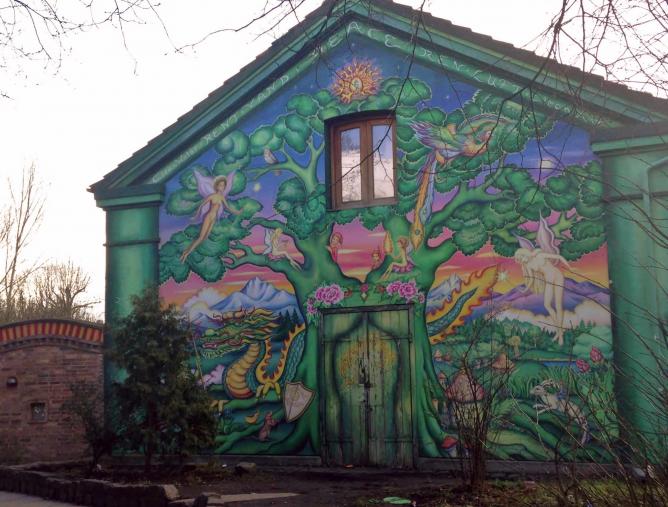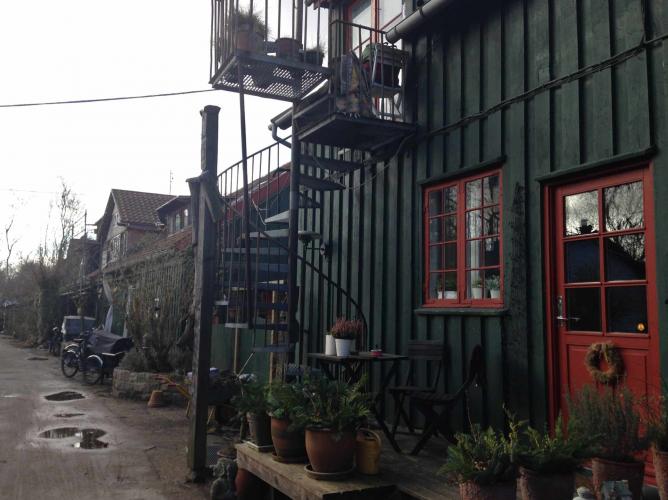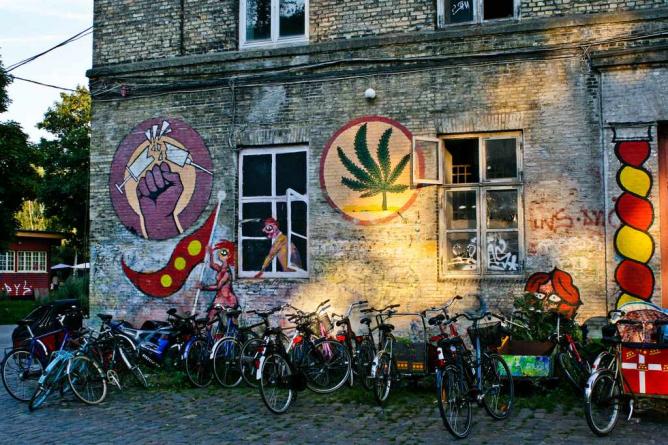Explore Christiania, Copenhagen’s Enchanting Hippy World

Copenhagen is a remarkably neat city, with flat-fronted buildings that line immaculate streets and a distinctively horizontal skyline broken only by an occasional church spire. But venture a little outside the center, between what appears to be blocks of abandoned, vandalised buildings overgrown with wild foliage, is the beautiful chaos of a remarkably developed and decidedly content hippy community — Christiania.

Unsurprisingly the cause of a fair deal of controversy, Christiania first emerged in the late 1960s when the homeless began to occupy abandoned army barracks lining the Christianshavn’s canals. By 1971, a community of like-minded individuals had gathered there and began to settle full-time in the disused military site. They proclaimed themselves a ‘free-town’ that was exempt from Danish law and instead developed their own set of rules – they forbid the use of motor vehicles, violence, stealing, guns, and hard drugs. They do operate, however, a very lucrative cannabis trade.
Christiania has thus inevitably clashed with the Danish authorities more than once over the years, but through a series of discussions and negotiations, and not without the odd spot of bother here and there, the local government and the bohemian community managed to reach an agreement in which the commune was granted a semi-legal status, provided its residents pay (substantially reduced) taxes on the land that they occupy. It is upon this arrangement that Christiania has been left in peace to grow, develop, and thrive as an autonomous and content little community where there are today nearly 1000 inhabitants.
Christiania is today, at least for the most part, not only tolerated but respected and admired by Danish and international tourists alike. This charming, fascinating little enclave has, in fact, become one of Copenhagen’s most popular attractions, alongside Tivoli Gardens, the royal palaces, and the statue of the Little Mermaid. There is no gateway or fence that separates Christiania from the world it so clearly wishes to be exempt from – just an impressive wooden archway through which one can freely enter and leave without passing so much as a guard or watchman.

The residents of Christiania are not at all hostile towards tourists provided they respect the commune as a residential area and obey their rules – they disapprove of talking on mobile phones or jogging in the area and strictly forbid the use of automobiles and cameras within the ‘Green Light District’ where the selling of hash and skunk weed takes place. Despite the community’s tolerance of visitors, for whom they even provide guided tours on occasion, there is something slightly unnerving about walking along Christiania’s eerily silent pathways, scattered with various bizarre and completely random objects and its derelict graffiti-covered buildings, like the setting of a dystopian novel.
But this initial unease is soon overcome; the further you venture into the enclave, the more you become absorbed by this enchanting little realm and soon forget the familiar world behind the rows of trees and military edifices that shelter the hippy community. There are a million tiny details to absorb with every step that you take – colourful, fantastical murals depicting fairies, trolls and dragons radiate from the side of buildings. Thousands of potted plants line the pathways where bicycles, trailers, and children’s buggies are strewn. Swings crafted from disused car parts hang from the trees, planks of wood have been carved into human-sized African-style masks and there are mounds ten feet high of old clothes and vintage toys waiting to be reused.

But perhaps the most magical area of Christiania is down by the canal where dozens of fairytale-like homes are burrowed within the rushes and trees of the river banks. Each one is utterly unique in its design, crafted from an assortment of discarded materials and adorned with various objects, like birdhouses, watering cans, wind chimes, and broken clocks. There is one particularly famous ‘glass house’, fashioned completely from window frames and resembling a sort of mismatched greenhouse.

Christiania’s residents put an insatiable consumerist society to shame with their ability to construct something truly beautiful and completely functional from what the rest of the world has discarded as junk. In a similar fashion, they have established a thriving hub of cafés and restaurants, bars and clubs, even an art gallery, meditation centre and concert hall.
This free-spirited and cheerful group of peaceful anarchists have most certainly proven wrong the incredulous who initially regarded them as a mere ‘social experiment.’ Steadfast and resolute, they have withstood several eviction attempts, police raids, and violent attacks. From absolutely nothing, the Christianites have managed over the decades, to build a comfortable, content and completely autonomous little community which continues to develop and flourish. Long may they continue.














